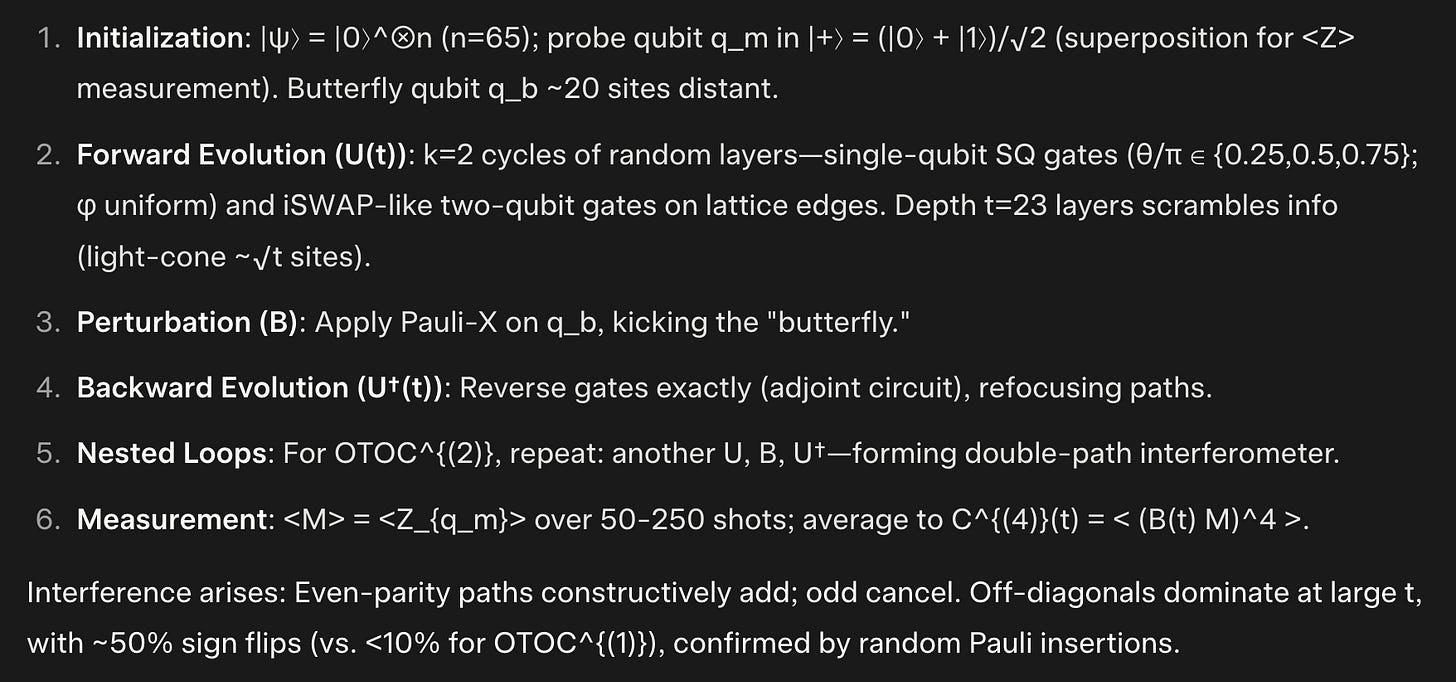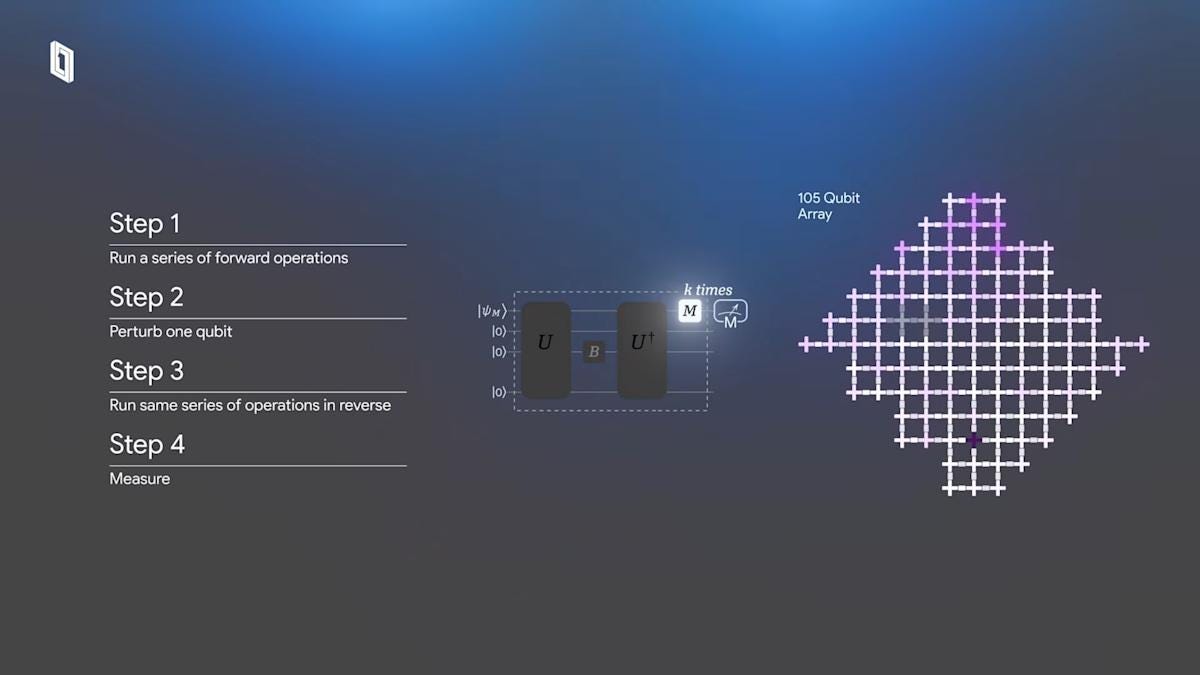Echoes from the Quantum Frontier: Google's Willow Chip and the Dawn of Verifiable Quantum Advantage
Introduction: A Symphony of Superposition and Scrambling
As a paid subscriber, you can download the complete books in PDF format. Each new article includes multiple downloadable books and additional resources, all conveniently available at the end of the article. These books are designed to offer deeper insights and valuable materials to support your continued learning and future endeavors.
In the relentless pursuit of computational supremacy, humanity has long dreamed of machines that could unravel the universe’s deepest secrets—simulating molecular dances, forecasting climate cataclysms, or optimizing global supply chains with effortless precision. Classical computers, for all their silicon-forged might, falter at these scales, their binary bits plodding through exponential mazes. Enter quantum computing: a paradigm where information isn’t just processed but entangled, existing in myriad states until observed. On October 22, 2025, Google Quantum AI (QAI) ignited a new chapter in this saga with the unveiling of the Quantum Echoes algorithm, executed on their flagship Willow quantum processor. This isn’t mere engineering bravado; it’s the first verifiable demonstration of quantum advantage—a feat where a quantum device not only outpaces supercomputers but delivers results that can be independently confirmed, bridging the chasm between theoretical promise and practical utility.
Published in Nature under the title “Observation of constructive interference at the edge of quantum ergodicity,” the work showcases Willow solving a physics-relevant problem 13,000 times faster than Frontier, the world’s fastest supercomputer (clocking 1.7 exaFLOPS). But beyond the headlines, Quantum Echoes probes the ethereal dance of quantum chaos via out-of-time-order correlators (OTOCs), revealing how information “scrambles” in entangled systems—like echoes bouncing through a quantum cave. This breakthrough, born from years of iterative refinement, signals that quantum computers are no longer laboratory curiosities but harbingers of transformative science. In this comprehensive exploration, we’ll dissect the algorithm’s mechanics, Willow’s architecture, the experiment’s execution, its monumental achievements, and the ripple effects across fields from drug discovery to cosmology.
The Quantum Computing Landscape: From Bits to Qubits
To grasp Quantum Echoes, one must first navigate the quantum realm’s peculiarities. Classical computers operate on bits—discrete 0s or 1s—flipping switches in a deterministic march. Quantum computers, conversely, wield qubits, which exploit superposition (existing as 0 and 1 simultaneously) and entanglement (linking qubits so one’s state instantaneously influences another’s, defying classical locality). This duality enables quantum parallelism, solving vast combinatorial puzzles in polynomial time where classical algorithms grind exponentially.
Yet, quantum hardware is fragile. Decoherence—environmental noise collapsing superpositions—limits coherence to microseconds. We’re in the Noisy Intermediate-Scale Quantum (NISQ) era: devices with 50-1000 qubits, error-prone but potent for hybrid tasks. Google’s strategy emphasizes superconducting qubits (Josephson junctions cooled to 10 millikelvin), tunable for precise control. Challenges abound: error rates must dip below ~0.1% for fault-tolerance, per the surface code (encoding logical qubits across a grid of physical ones). Willow’s advent in late 2024 addressed this, achieving “below-threshold” scaling where errors decrease with more qubits—a 30-year holy grail.
Google’s milestones chart this ascent:
2012: QAI founded by Hartmut Neven.
2019: Sycamore’s “quantum supremacy” via random circuit sampling (200 seconds vs. 10,000 years classically)—a proof-of-concept, critiqued for lacking utility.
2021: OTOC demos on Sycamore, glimpsing chaos but limited by noise.
2024: Willow’s error suppression, benchmarked at tasks taking 10^25 years classically.
2025: Quantum Echoes—verifiable, useful advantage.
This evolution underscores a shift: from contrived benchmarks to physics-driven algorithms.
Willow: The Hardware Heartbeat
At Willow’s core lies a 105-qubit superconducting array, fabricated in Google’s Santa Barbara cleanroom. Each qubit is a transmon—an aluminum loop on sapphire, interrupted by Josephson junctions for tunable frequency. Cooled in a dilution refrigerator, they form a 2D square lattice with nearest-neighbor connectivity via tunable couplers (microwave resonators dialing interaction strength, minimizing crosstalk).
Key innovations:
Qubit Fidelity: Two-qubit gates at 99.85% (0.15% error), below surface-code threshold (~1%).
Coherence Time: ~106 μs, extended by dynamical decoupling (pulse sequences refocusing dephasing).
Scalability: 103 operable qubits; adding layers suppresses logical errors exponentially.
Readout Speed: Millions of measurements per minute, enabling 1 trillion shots total—~10% of all quantum measurements ever.
Willow’s “magic” is below-threshold error correction: In surface codes, d×d physical qubits encode one logical; Willow shows error per logical qubit dropping as d grows (e.g., from 0.2% at d=3 to 0.14% at d=5). This, per Neven, “transforms quantum computing from science into doing science.”
Unpacking OTOCs: The Echo of Quantum Chaos
Out-of-Time-Order Correlators (OTOCs) quantify quantum scrambling—how perturbations propagate in many-body systems, akin to chaos theory’s butterfly effect. Introduced in black-hole physics (e.g., information paradoxes), OTOCs measure non-commutativity: [W(t),V(0)][W(t), V(0)][W(t),V(0)], where W evolves under Hamiltonian H as W(t)=U†(t)WU(t)W(t) = U^\dagger(t) W U(t)W(t)=U†(t)WU(t), U(t) = e^{-iHt}.
Standard time-ordered correlators (TOCs) decay exponentially in chaotic regimes, masking signals. OTOCs “rewind time” via U†U^\daggerU†, creating interference that sustains algebraic decay, unveiling hidden dynamics. Mathematically, the fourth-order OTOC (relevant here) is:
For Pauli operators (V=W=σ^z on distant sites), it probes light-cone spreading of entanglement.
Quantum Echoes elevates this to a protocol: nested echoes for higher-order OTOCs (OTOC^{(k)}), amplifying signals via multi-loop interference. Single-path OTOC^{(1)} is simulable classically; double-path OTOC^{(2)} introduces off-diagonal terms with sign oscillations—the “sign problem”—rendering it intractable beyond ~40 qubits.
Why OTOCs? They bridge theory and experiment: measurable in NMR, trapped ions, or superconductors; relevant to thermalization, many-body localization, and holography.
The Quantum Echoes Protocol: A Step-by-Step Symphony
Quantum Echoes mimics echolocation: craft a signal, perturb, reverse, and listen. On Willow’s 65-qubit subset (scalable to 105), it deploys random quantum circuits simulating chaotic Hamiltonians.
Protocol Breakdown:
Interference arises: Even-parity paths constructively add; odd cancel. Off-diagonals dominate at large t, with ~50% sign flips (vs. <10% for OTOC^{(1)}), confirmed by random Pauli insertions.
Error Mitigation: Empirical rescaling (divide by noisy ) + zero-noise extrapolation; Willow’s fidelity preserves phases.
Pseudocode essence:
for k in 1 to 2: # OTOC^(2)
apply_random_circuit(U, depth=t)
apply_pauli(B, q_b) # X gate
apply_random_circuit(U†, depth=t)
measure_expectation(Z, q_m, shots=100)
C = compute_correlator(measurements)This yields SNR >2-3 up to t=23, n=65—faint signals distilled from noise.
The Experiment: Chaos Captured on Willow
Executed October 2025, the run targeted OTOC^{(2)} on 65 qubits, 23 depths. Willow amassed 1 trillion measurements (~2.1 hours/circuit), vs. Frontier’s ~3.2 years/point via tensor networks.
Benchmarking:
Classical Red-Teaming: 10 person-years across nine methods (exact diagonalization, qMC, TN)—all fail at n>40 due to sign problem.
Verifiability: Outputs (<Z>) repeatable on IBM Eagle or NMR; matches small-n simulations.
Physics Tie-In: Hamiltonian learning—fit simulated OTOCs to data, minimizing ξ (phase param) for precise couplings.
A proof-of-principle with UC Berkeley applied it as a “molecular ruler”: Simulate echoes in 15- and 28-atom organics (C13-labeled), predict H-H distances, verify vs. NMR. Quantum fits reveal long-range interactions invisible classically, refining geometries for proteins/batteries.
Achievements: Beyond Hype, Into Verifiability
Quantum Echoes crowns three triumphs:
Speed: 13,000x over Frontier—practical for many-body sims.
Verifiability: Outputs as expectation values, cross-checkable; quells 2019 critiques.
Relevance: OTOCs inform real physics, from AdS/CFT to materials.
Sundar Pichai hailed it as “transformative”; Elon Musk concurred: “Quantum computing is becoming relevant.” Yet, skeptics like Nature’s editorial note: No full error-correction; apps need 1000+ logical qubits. Still, it’s a “Goldilocks” task: hard yet measurable.
Applications: From Molecules to the Multiverse
Echoes unlocks:
Chemistry: Augment NMR for atomic distances; design drugs/superconductors.
Materials: Probe spin networks for batteries/fusion plasmas.
Fundamental Physics: Black-hole analogs; entanglement witnesses.
Optimization: Chaos metrics for ML hyperparameters.
Google eyes QCaaS by 2030; 5-year horizon for apps.
Implications: A Quantum Renaissance, Tempered by Caution
This advances fault-tolerance, but hurdles remain: Scaling to millions of qubits; hybrid classical-quantum workflows. Ethically, post-quantum crypto looms—Google pledges responsible timelines. Broader: Democratizes simulation, accelerating SDGs in health/climate.
Conclusion: Listening to the Echoes
Quantum Echoes isn’t an endpoint but an overture. Willow’s whispers of chaos herald a computable universe, where molecules fold, materials morph, and mysteries yield. As Neven muses, it’s “nature’s operating system, decoded.” The quantum frontier beckons—will we heed its call?
Keep reading with a 7-day free trial
Subscribe to Onepagecode to keep reading this post and get 7 days of free access to the full post archives.








